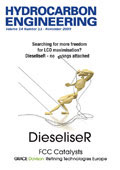Editorial comment
In North America and Western Europe, the 2009 - 2010 refined product market is and will be challenging at best. Light-to-heavy differentials are at historic lows and refined product stocks are at record highs. Whereas in 2006 and 2007 the market was predicting a forthcoming supply shortage, the world is now forecasting significant overcapacity for the near future. The concomitant mixture of added refined capacity, economic recession and uncertainty, and regulatory reaction to climate change is not conducive to major refinery investments.
Register for free »
Get started now for absolutely FREE, no credit card required.
Few refiners are actually considering increasing production capacity, which might signal that the technology outlook is not particularly attractive. On the other hand, those that have the technical expertise to drive down costs, and to capture margin from rapid changes in market demand, are in an excellent position to come out of this downturn with momentum. Refining is a mature market with low to negative average annual growth expected in most OECD countries. From a business perspective, it is clear that spend on new technologies requiring large investments for implementation should be allocated to applications in growth businesses and regions, whereas R&D investments for mature markets should focus on low capital solutions that improve performance and cost efficiency. There are several technology areas that can deliver major boosts to refinery operations and that do not involve large capital expenditures. BP focuses on key areas that enable cost reduction, and that positively affect planning, reliability and safety. Two low cost technology areas merit special attention: remote corrosion detection and equipment monitoring. The use of economically advantageous feedstocks often corresponds to significant operational challenges including, unfortunately, increased corrosion. The increased margin resulting from processing ‘opportunity’ crudes is often partially offset by the increased cost in maintenance. Corrosion monitoring, depending on how it is done, is time consuming and expensive. To offset the need for extensive manual plant inspection, online corrosion devices can be installed and hard wired into the plant data system. However, this is costly considering the number of detection areas that need to be examined. The use of remote, wireless enabled, online corrosion monitoring systems is at the technical leading edge of corrosion monitoring. Remote monitoring can provide a continuous measure of corrosion and consequently better maintenance planning, more accurate downside cost analysis, and ultimately better feedstock purchasing decisions. Similarly, application of ‘predictive analytics’ technology to equipment monitoring, coupled with wireless instrumentation, has enabled BP to detect potential problems before they could cause serious operational dysfunction. Both of these devices are low cost, technologically intensive solutions that have been installed in significant numbers in BP refineries, enabling better maintenance planning, safety and continuous operations. These low cost technologies make a difference between planned and unplanned plant downtime and improve both safety and reliability of operations. For further details, please visit http://www.gtforum.com/ertc-annual-meeting/

